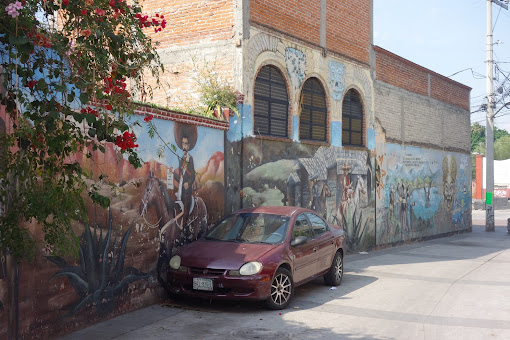As I left the Sanctuary of the Lord of Calvary, I notice that the street past the church had a number of mural paintings.
The paintings were not in the best of condition and needed touch-ups, but they were interesting. Doing a bit of research afterwards later on, I even learned a couple of things about Mexican history.
The first section of murals has images from pre-Hispanic civilizations.
Next to it is a scene which obviously depicts the legendary foundation of the Aztec capital of Tenochtitlan. Supposedly they built their city on an island in the lake when they saw the omen of an eagle perched on a cactus.
The caption on the mural says, "Culhuacán. The Aztec people admired your progress and courage and because of that requested Acamapichtli as guide." I later looked up Acamapichtli, and discovered that he was a prince from Culhuacán whom the Aztecs chose to be their first chief.
The next painting depicts men and women riding off on horseback to fight in the Mexican Revolution.
Next are portraits of a couple heroes of the Mexican Revolution. First is Emiliano Zapata, one of the more idealistic of the revolutionaries. He fought to give land to the peasants, and here he holds a scroll saying, "The land belongs to those who work it."
I later discovered that Zapata had a connection with Culhuacán. When Zapata and his army marched to Mexico City, he and his chief revolutionary rival, Venustiano Carranza, skirmished briefly at Culhuacán.
Next to Zapata, is a portrait of another hero of the revolution, Pancho Villa.
This painting shows the two volcanoes Iztaccíhuatl and Popocatépetln outside of Mexico City. In the foreground are "chinampas", the so-called "floating gardens", a unique form of agriculture in pre-Hispanic times. The natives of the Valley of Mexico would build rafts on the shallow lake, pile soil on top of them, and plant crops. Eventually the rafts would become rooted to the lake bottom forming a network of canals and islands. As the lakes of the valley were drained, most of the "chinampas", including those in Culhuacán, disappeared. Only in the southern district of Xochimilco do the canals and "chinampas" still survive.
I headed back to the Metro station to return to my apartment, glad that I had taken a trip to Culhuacán.









No comments:
Post a Comment